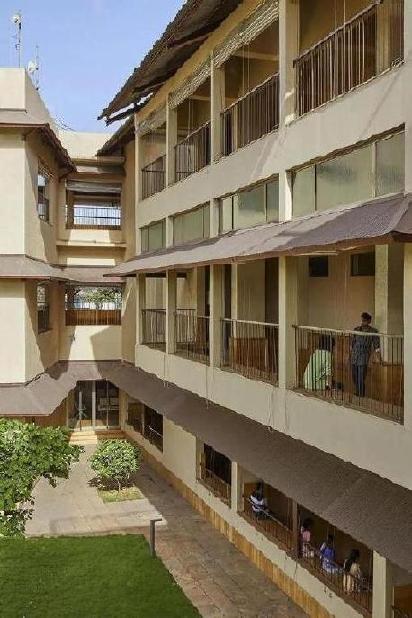As the first multi specialty hospital in Dolvi village, Maharashtra, where infrastructure is scarce, JSW Sanjeevani not only provides better medical services to the local community, but also promotes economic growth and infrastructure construction in the region..

This hospital, which can accommodate 100 beds, has good lighting and ventilation, and is located next to the Goa Expressway in Mumbai. It is both easy to reach and helps to solve high-frequency accidents in the area..

Overall, the hospital is located in the center of the site, with a parking lot on the north side and auxiliary facilities behind the building. Both hospitals and service areas have clear signs and entrances to ensure unobstructed access for personnel and vehicles..

In the building, architects have designed clear horizontal and vertical flow zones for the emergency room, patients, and staff to facilitate traffic guidance. The first floor space includes emergency services, outpatient departments, diagnostic rooms, and other forms of nursing services. The upper space has an inpatient department, with OTs and ICUs concentrated on the first floor, while the ward is arranged on the second floor..

In order to guide people to pass through multiple zones, all corridors in non clinical areas are paved with ochre Ita gold limestone to form a clear and visible passage. On the western periphery of the building, the hospital also provides a separate service entrance on the first floor for passengers passing through adjacent national highways, allowing them to enter the cafeteria and public restrooms..


On the south and north facades of the building, there are two consecutive balconies on the first and second floors, respectively. Considering the coastal climate of Dolvey, the corridors and balconies have been specially protected for heavy rain weather. Meanwhile, this design creates east-west air ducts from the southwest and west sides, allowing residents to feel cool even in hot and humid weather..

The terrace extending from one floor promotes lighting and ventilation, creating a healthy environment for recuperation and rehabilitation. Through this design, the architect strictly controlled the air conditioning usage in the core consultation room, saving 50 watts of electricity per square meter and reducing the spread of bacteria. Only 20% of core clinics require HVAC systems throughout the day. 30% of the consultation rooms are equipped with natural ventilation and temporary air conditioning systems, while the remaining 50% are public corridors and waiting areas with natural ventilation..

On the basis of passive energy-saving design, the hospital has also taken some measures to ensure more sustainable operation. The waste slag generated during the production process of the nearby steel plant is used as foundation filling, thereby saving soil. In addition, rainwater from artificial landscapes and terraces is also collected and filtered before being stored again. The landscape design adopts permeable surfaces to achieve surface replenishment..

The water treated by STP (sewage treatment plant) and ETP (wastewater treatment plant) can be recycled and reused for irrigation and flushing systems in hospital landscapes. In addition, the hospital has also adopted the earthworm composting method to decompose kitchen waste and improve soil fertility. A centralized 6000L solar water heater system has also been installed in the hospital. Other energy-saving features include a variable cold pump system to minimize air conditioning load, a carbon monoxide sensor for absorbing fresh air, a dual flush water system to save water resources, and a water-saving faucet covering all bathrooms..





























